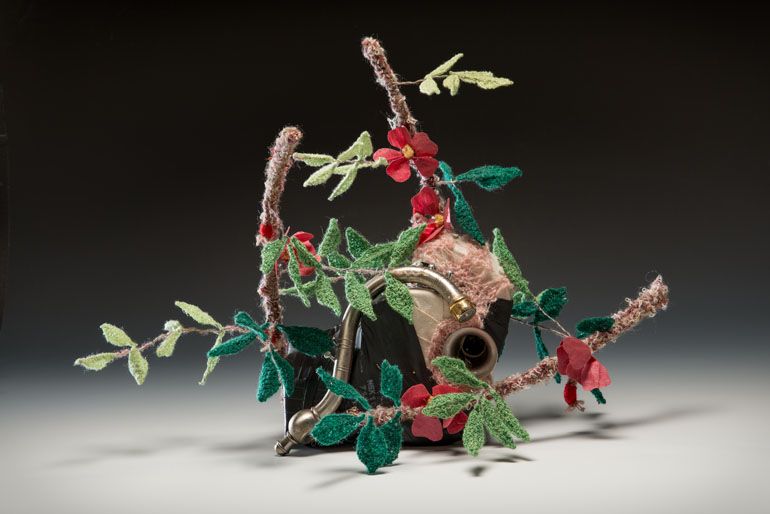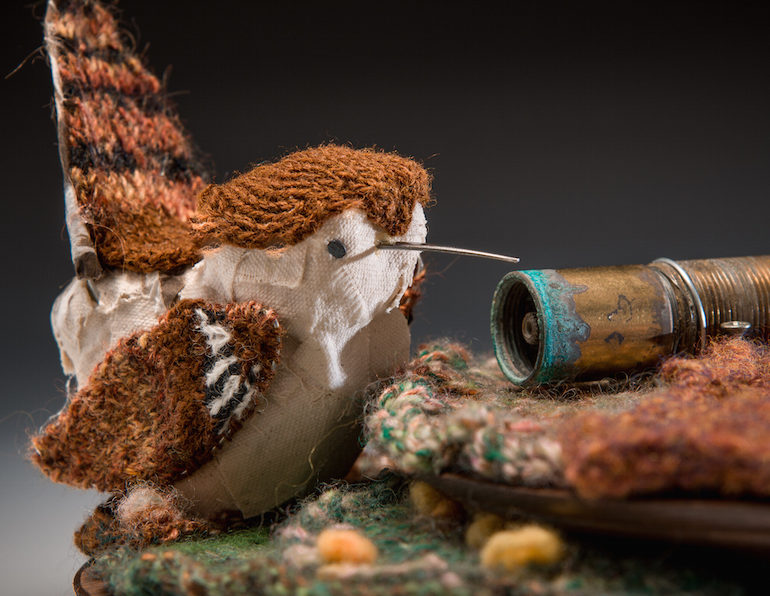
Rosa, the Resurgent Beauty, knitted yarns, fused silk, wire, canvas, rubber, discarded trash, 18 x 23 x 14 inches, $650. Photo by paulrogersphotography.com. ©2016 Eve Jacobs-Carnahan
Telling Stories with Trash
“Wait, don‘t throw that out. Maybe I can use it.” That item about to hit the trash might be just the right shape for a beak or a tail, adding a surprise twist. More importantly, it might be an essential element in a serious story about the impact of people on nature.
We had a new roof put on our house this summer, and I collected a pile of nails and screws that the construction crew dropped. Toes for birds? Spikes for a fence? I don’t know yet, but I’m saving them.

I also pick up forlorn items that people leave in their front yards in “free” piles. This odd local practice stems from a desire to avoid throwing things in the landfill. People leave things on the sidewalk hoping someone will take them and re-use them.
The same impulse fuels the yard sales in my area. My best yard sale find was a box of old plumbing parts. They have made their way into two sculptures so far, and I still have a lot left.

Art for Lawyers
I first used these metal hoses and fixtures in Rosa, the Resurgent Beauty. In that piece, the junk was literally meant to represents a trash pile. The hardy rose shrub pushing through the trash brought beauty to the scene. Rosa Rugosa shrubs can withstand harsh conditions and are often planted around parking lots. They have lovely flowers and a heady spicy scent.
Rosa, the Resurgent Beauty, knitted yarns, fused silk, wire, canvas, rubber, discarded trash, 18 x 23 x 14 inches, $650. Photo by paulrogersphotography.com. ©2016 Eve Jacobs-Carnahan
The plumbing parts I incorporated into Encroachment represent the vanguard of real estate development. Laying the infrastructure of water and sewer pipes is the first step in preparing land for construction. I wanted to juxtapose manmade materials with the sweet storybook scene of little birds in the marsh. While we know how the wetlands will change when the bulldozers move in, the birds are unaware of the import of these intrusion.
Enlivening the Story
Yard sales are great to peruse in the summer, but for the rest of the year, there’s the Resource store. This Vermont non-profit works on “finding value in every one and every thing.” The organization provides job training in part by running a store that accepts cast off goods for resale.
On one of my visits, I picked up some wood serving trays for corn on the cob. I cut one in half and turned the pieces to face each other, forming the beak of the pelican in Trawling the Algae Overload.
Trawling the Algae Overload, wool yarns, felted wool, mulberry paper, rubber inner tubes, corn on the cob tray, canvas, wire, acrylic paint, 13 x 28 x 22 inches, $800. Photo by paulrogersphotography.com. ©2017 Eve Jacobs-Carnahan
Not only is the tray the right shape for the pelican’s beak, but it adds to the story. The bird’s beak is empty because it cannot find food in the dead black water. The lake is choked with algae, a result of the overload of nutrient runoff from industrial agriculture. The corn cob tray ties the bird to the Iowa cornfields that kill off the fish.
I was inspired to create this piece after hearing about the dead zone where the Mississippi River empties into the Gulf of Mexico. Agricultural practices upstream in Iowa and Minnesota are the root of the problem. The petro-chemical industry has made farmers reliant on heavy fertilizer use that pollutes the river.
The dynamics of this relationship were reported by a small town newspaper in Storm Lake, Iowa. Art Cullen, the journalist who put together this story, won a Pulitzer Prize in 2017 for his work. Here’s a fascinating interview with him on the podcast On Point, along with a farmer, an environmentalist, and others knowledgeable about these agricultural practices.
When I save stray objects or broken parts, I don’t always know how I will use them in my artwork. That’s part of the fun of exploring ideas and finding ways to tell stories. When you see an object in my sculpture that looks out of place, I hope you’ll stop and ask “what is that doing there?” In most cases, it points to the impact of people on nature.



Reusing found materials in art adds such a wonderful and unexpected layer of depth to the work and the message. I hope you saw “High Trash” at the Fleming in 2013 – it was quite inspiring.
I didn’t see that show but I just read a review of it in Seven Days. It must have been fun to see such intensive use of trash as artistic medium.